Financial Analysis Report: Gatsby Grange Hotel Performance 2018-2019
VerifiedAdded on 2023/01/06
|10
|3071
|43
Report
AI Summary
This report provides a comprehensive financial analysis of Gatsby Grange, a small chain boutique hotel in the UK. The analysis focuses on calculating and interpreting profitability, liquidity, and gearing ratios for 2018 and 2019 to assess the hotel's financial performance. The report delves into the importance of understanding ratio fluctuations for hotel management, highlighting their role in analyzing financial statements and making informed decisions. Furthermore, it discusses the benefits and limitations of using ratio analysis within the hotel and tourism industry, providing insights into its practical application and potential drawbacks. The report concludes with an overview of the financial trends observed and their implications for Gatsby Grange's financial health and strategic decision-making.
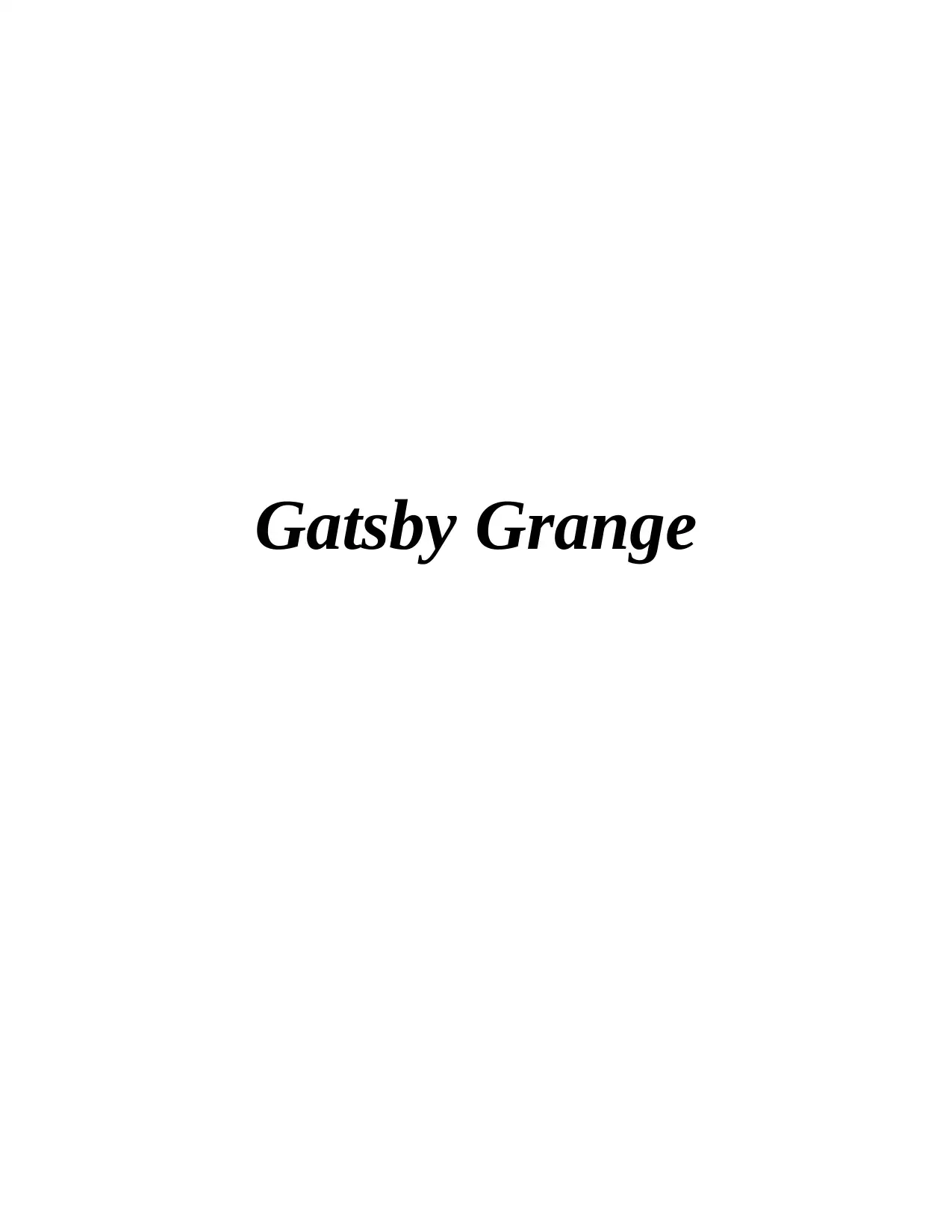
Gatsby Grange
Paraphrase This Document
Need a fresh take? Get an instant paraphrase of this document with our AI Paraphraser
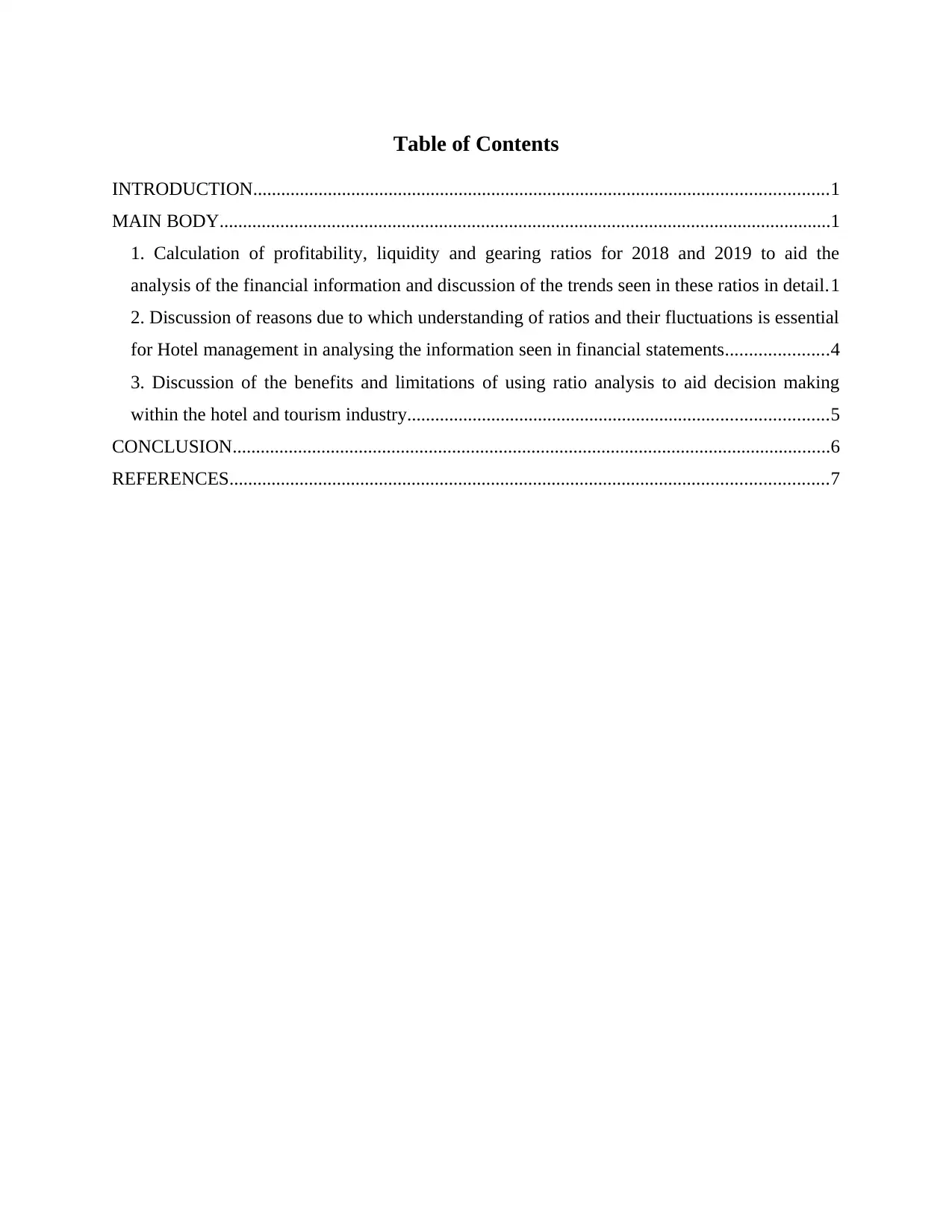
Table of Contents
INTRODUCTION...........................................................................................................................1
MAIN BODY...................................................................................................................................1
1. Calculation of profitability, liquidity and gearing ratios for 2018 and 2019 to aid the
analysis of the financial information and discussion of the trends seen in these ratios in detail.1
2. Discussion of reasons due to which understanding of ratios and their fluctuations is essential
for Hotel management in analysing the information seen in financial statements......................4
3. Discussion of the benefits and limitations of using ratio analysis to aid decision making
within the hotel and tourism industry..........................................................................................5
CONCLUSION................................................................................................................................6
REFERENCES................................................................................................................................7
INTRODUCTION...........................................................................................................................1
MAIN BODY...................................................................................................................................1
1. Calculation of profitability, liquidity and gearing ratios for 2018 and 2019 to aid the
analysis of the financial information and discussion of the trends seen in these ratios in detail.1
2. Discussion of reasons due to which understanding of ratios and their fluctuations is essential
for Hotel management in analysing the information seen in financial statements......................4
3. Discussion of the benefits and limitations of using ratio analysis to aid decision making
within the hotel and tourism industry..........................................................................................5
CONCLUSION................................................................................................................................6
REFERENCES................................................................................................................................7
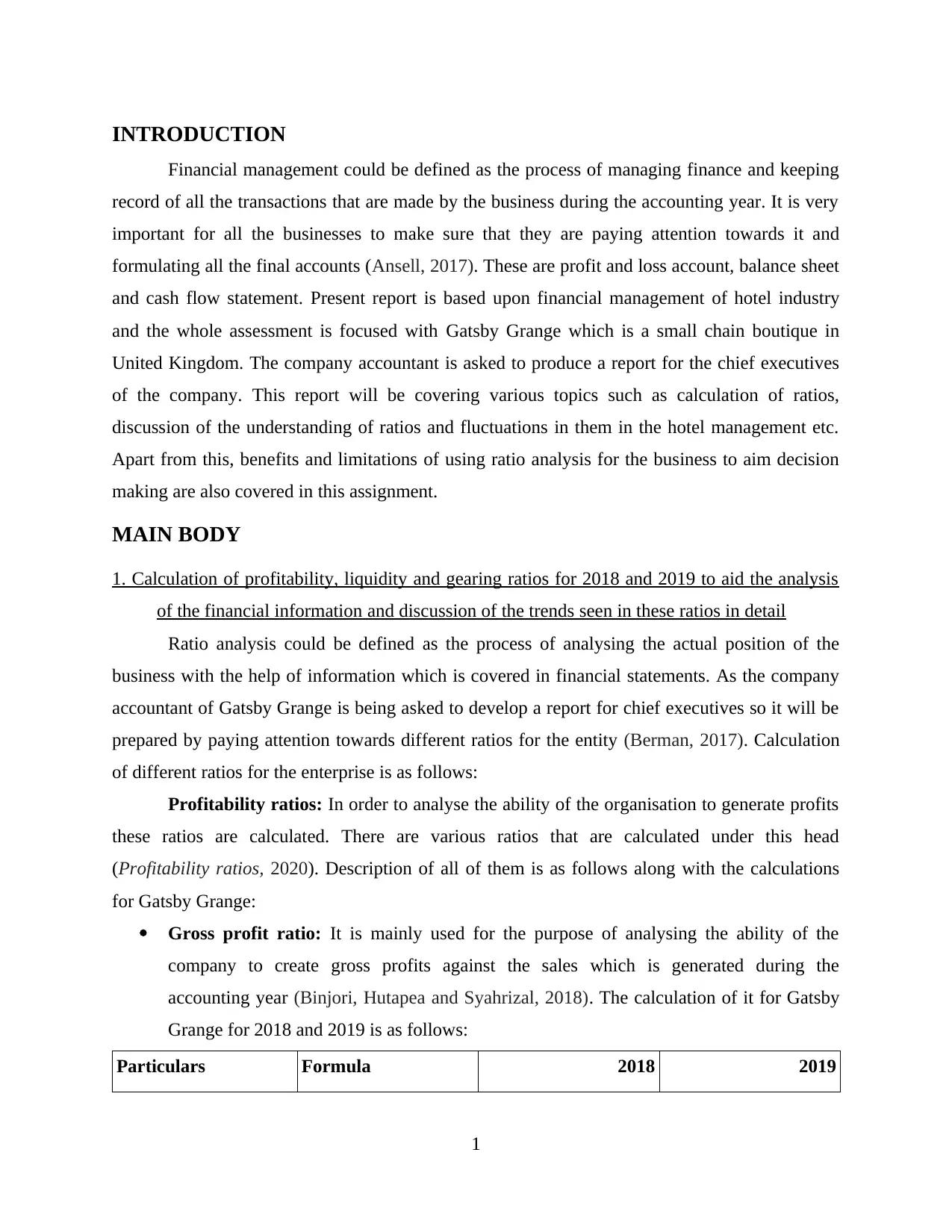
INTRODUCTION
Financial management could be defined as the process of managing finance and keeping
record of all the transactions that are made by the business during the accounting year. It is very
important for all the businesses to make sure that they are paying attention towards it and
formulating all the final accounts (Ansell, 2017). These are profit and loss account, balance sheet
and cash flow statement. Present report is based upon financial management of hotel industry
and the whole assessment is focused with Gatsby Grange which is a small chain boutique in
United Kingdom. The company accountant is asked to produce a report for the chief executives
of the company. This report will be covering various topics such as calculation of ratios,
discussion of the understanding of ratios and fluctuations in them in the hotel management etc.
Apart from this, benefits and limitations of using ratio analysis for the business to aim decision
making are also covered in this assignment.
MAIN BODY
1. Calculation of profitability, liquidity and gearing ratios for 2018 and 2019 to aid the analysis
of the financial information and discussion of the trends seen in these ratios in detail
Ratio analysis could be defined as the process of analysing the actual position of the
business with the help of information which is covered in financial statements. As the company
accountant of Gatsby Grange is being asked to develop a report for chief executives so it will be
prepared by paying attention towards different ratios for the entity (Berman, 2017). Calculation
of different ratios for the enterprise is as follows:
Profitability ratios: In order to analyse the ability of the organisation to generate profits
these ratios are calculated. There are various ratios that are calculated under this head
(Profitability ratios, 2020). Description of all of them is as follows along with the calculations
for Gatsby Grange:
Gross profit ratio: It is mainly used for the purpose of analysing the ability of the
company to create gross profits against the sales which is generated during the
accounting year (Binjori, Hutapea and Syahrizal, 2018). The calculation of it for Gatsby
Grange for 2018 and 2019 is as follows:
Particulars Formula 2018 2019
1
Financial management could be defined as the process of managing finance and keeping
record of all the transactions that are made by the business during the accounting year. It is very
important for all the businesses to make sure that they are paying attention towards it and
formulating all the final accounts (Ansell, 2017). These are profit and loss account, balance sheet
and cash flow statement. Present report is based upon financial management of hotel industry
and the whole assessment is focused with Gatsby Grange which is a small chain boutique in
United Kingdom. The company accountant is asked to produce a report for the chief executives
of the company. This report will be covering various topics such as calculation of ratios,
discussion of the understanding of ratios and fluctuations in them in the hotel management etc.
Apart from this, benefits and limitations of using ratio analysis for the business to aim decision
making are also covered in this assignment.
MAIN BODY
1. Calculation of profitability, liquidity and gearing ratios for 2018 and 2019 to aid the analysis
of the financial information and discussion of the trends seen in these ratios in detail
Ratio analysis could be defined as the process of analysing the actual position of the
business with the help of information which is covered in financial statements. As the company
accountant of Gatsby Grange is being asked to develop a report for chief executives so it will be
prepared by paying attention towards different ratios for the entity (Berman, 2017). Calculation
of different ratios for the enterprise is as follows:
Profitability ratios: In order to analyse the ability of the organisation to generate profits
these ratios are calculated. There are various ratios that are calculated under this head
(Profitability ratios, 2020). Description of all of them is as follows along with the calculations
for Gatsby Grange:
Gross profit ratio: It is mainly used for the purpose of analysing the ability of the
company to create gross profits against the sales which is generated during the
accounting year (Binjori, Hutapea and Syahrizal, 2018). The calculation of it for Gatsby
Grange for 2018 and 2019 is as follows:
Particulars Formula 2018 2019
1
⊘ This is a preview!⊘
Do you want full access?
Subscribe today to unlock all pages.

Trusted by 1+ million students worldwide

Gross profit
Gross profit / sales *
100
5050 5150
Sales 5500 6000
Gross profit ratio 91.82 85.83
Net profit ratio: While planning to determine relationship between net profit and
revenues of the organisation this ratio is calculated that helps to analyse actual
profitability of the company (Castillo, 2020). For Gatsby Grange all the calculations of it
for 2018 and 2019 are made below:
Particulars Formula 2018 2019
Net profit
Net profit / sales * 100
4008 4073
Sales 5500 6000
Net profit ratio 72.87 67.88
From the net and gross profit ratios it has been evaluated that the ratios are following
decreasing trend as both of them were high in 2018 as compared to 2019. It demonstrates that
ability of the entity is decreased to generate profits in 2019.
Liquidity ratios: All the ratios that are used by businesses for analysing their liquid
strength are known as liquidity ratios (Rodrigues and Rodrigues, 2018). These are mainly used
for determining the position of the business. Different types of it are calculated below for Gatsby
Grange:
Current ratio: It is used for the purpose of determining relationship between current
assets and liabilities. It can help Gatsby Grange to analyse its ability to make payment of
all the short term obligations within a year (Stanley, 2020). The calculation of it for the
boutique is as follows:
Particulars Formula 2018 2019
Current assets
Current assets /
current liabilities
3065 3240
Current liabilities 1339 1616
Current ratio 2.29 2.00
Quick ratio: It is also a liquidity ratio which is used by businesses for the purpose of
analysing the ability of an entity to make payment of all the short term liabilities in less
2
Gross profit / sales *
100
5050 5150
Sales 5500 6000
Gross profit ratio 91.82 85.83
Net profit ratio: While planning to determine relationship between net profit and
revenues of the organisation this ratio is calculated that helps to analyse actual
profitability of the company (Castillo, 2020). For Gatsby Grange all the calculations of it
for 2018 and 2019 are made below:
Particulars Formula 2018 2019
Net profit
Net profit / sales * 100
4008 4073
Sales 5500 6000
Net profit ratio 72.87 67.88
From the net and gross profit ratios it has been evaluated that the ratios are following
decreasing trend as both of them were high in 2018 as compared to 2019. It demonstrates that
ability of the entity is decreased to generate profits in 2019.
Liquidity ratios: All the ratios that are used by businesses for analysing their liquid
strength are known as liquidity ratios (Rodrigues and Rodrigues, 2018). These are mainly used
for determining the position of the business. Different types of it are calculated below for Gatsby
Grange:
Current ratio: It is used for the purpose of determining relationship between current
assets and liabilities. It can help Gatsby Grange to analyse its ability to make payment of
all the short term obligations within a year (Stanley, 2020). The calculation of it for the
boutique is as follows:
Particulars Formula 2018 2019
Current assets
Current assets /
current liabilities
3065 3240
Current liabilities 1339 1616
Current ratio 2.29 2.00
Quick ratio: It is also a liquidity ratio which is used by businesses for the purpose of
analysing the ability of an entity to make payment of all the short term liabilities in less
2
Paraphrase This Document
Need a fresh take? Get an instant paraphrase of this document with our AI Paraphraser
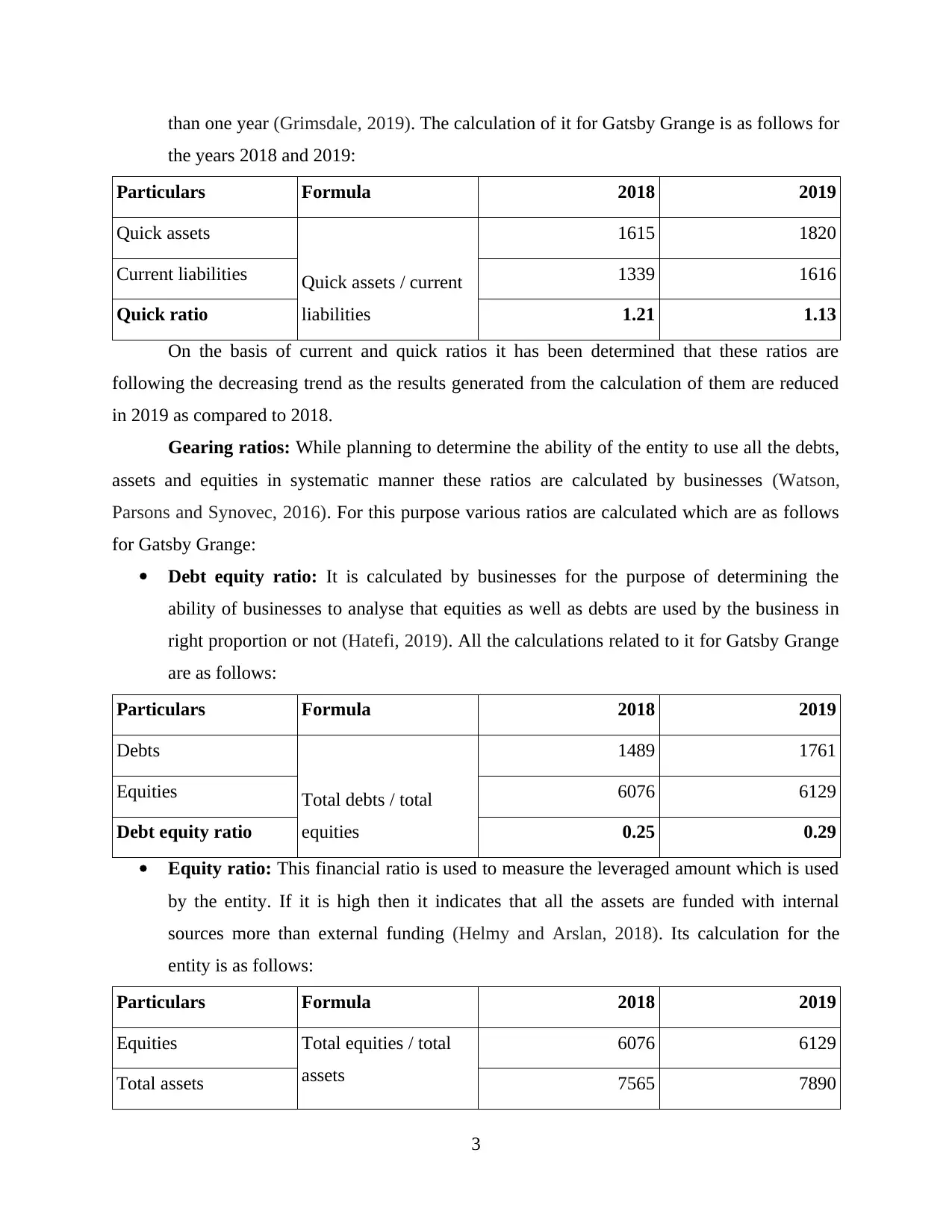
than one year (Grimsdale, 2019). The calculation of it for Gatsby Grange is as follows for
the years 2018 and 2019:
Particulars Formula 2018 2019
Quick assets
Quick assets / current
liabilities
1615 1820
Current liabilities 1339 1616
Quick ratio 1.21 1.13
On the basis of current and quick ratios it has been determined that these ratios are
following the decreasing trend as the results generated from the calculation of them are reduced
in 2019 as compared to 2018.
Gearing ratios: While planning to determine the ability of the entity to use all the debts,
assets and equities in systematic manner these ratios are calculated by businesses (Watson,
Parsons and Synovec, 2016). For this purpose various ratios are calculated which are as follows
for Gatsby Grange:
Debt equity ratio: It is calculated by businesses for the purpose of determining the
ability of businesses to analyse that equities as well as debts are used by the business in
right proportion or not (Hatefi, 2019). All the calculations related to it for Gatsby Grange
are as follows:
Particulars Formula 2018 2019
Debts
Total debts / total
equities
1489 1761
Equities 6076 6129
Debt equity ratio 0.25 0.29
Equity ratio: This financial ratio is used to measure the leveraged amount which is used
by the entity. If it is high then it indicates that all the assets are funded with internal
sources more than external funding (Helmy and Arslan, 2018). Its calculation for the
entity is as follows:
Particulars Formula 2018 2019
Equities Total equities / total
assets
6076 6129
Total assets 7565 7890
3
the years 2018 and 2019:
Particulars Formula 2018 2019
Quick assets
Quick assets / current
liabilities
1615 1820
Current liabilities 1339 1616
Quick ratio 1.21 1.13
On the basis of current and quick ratios it has been determined that these ratios are
following the decreasing trend as the results generated from the calculation of them are reduced
in 2019 as compared to 2018.
Gearing ratios: While planning to determine the ability of the entity to use all the debts,
assets and equities in systematic manner these ratios are calculated by businesses (Watson,
Parsons and Synovec, 2016). For this purpose various ratios are calculated which are as follows
for Gatsby Grange:
Debt equity ratio: It is calculated by businesses for the purpose of determining the
ability of businesses to analyse that equities as well as debts are used by the business in
right proportion or not (Hatefi, 2019). All the calculations related to it for Gatsby Grange
are as follows:
Particulars Formula 2018 2019
Debts
Total debts / total
equities
1489 1761
Equities 6076 6129
Debt equity ratio 0.25 0.29
Equity ratio: This financial ratio is used to measure the leveraged amount which is used
by the entity. If it is high then it indicates that all the assets are funded with internal
sources more than external funding (Helmy and Arslan, 2018). Its calculation for the
entity is as follows:
Particulars Formula 2018 2019
Equities Total equities / total
assets
6076 6129
Total assets 7565 7890
3
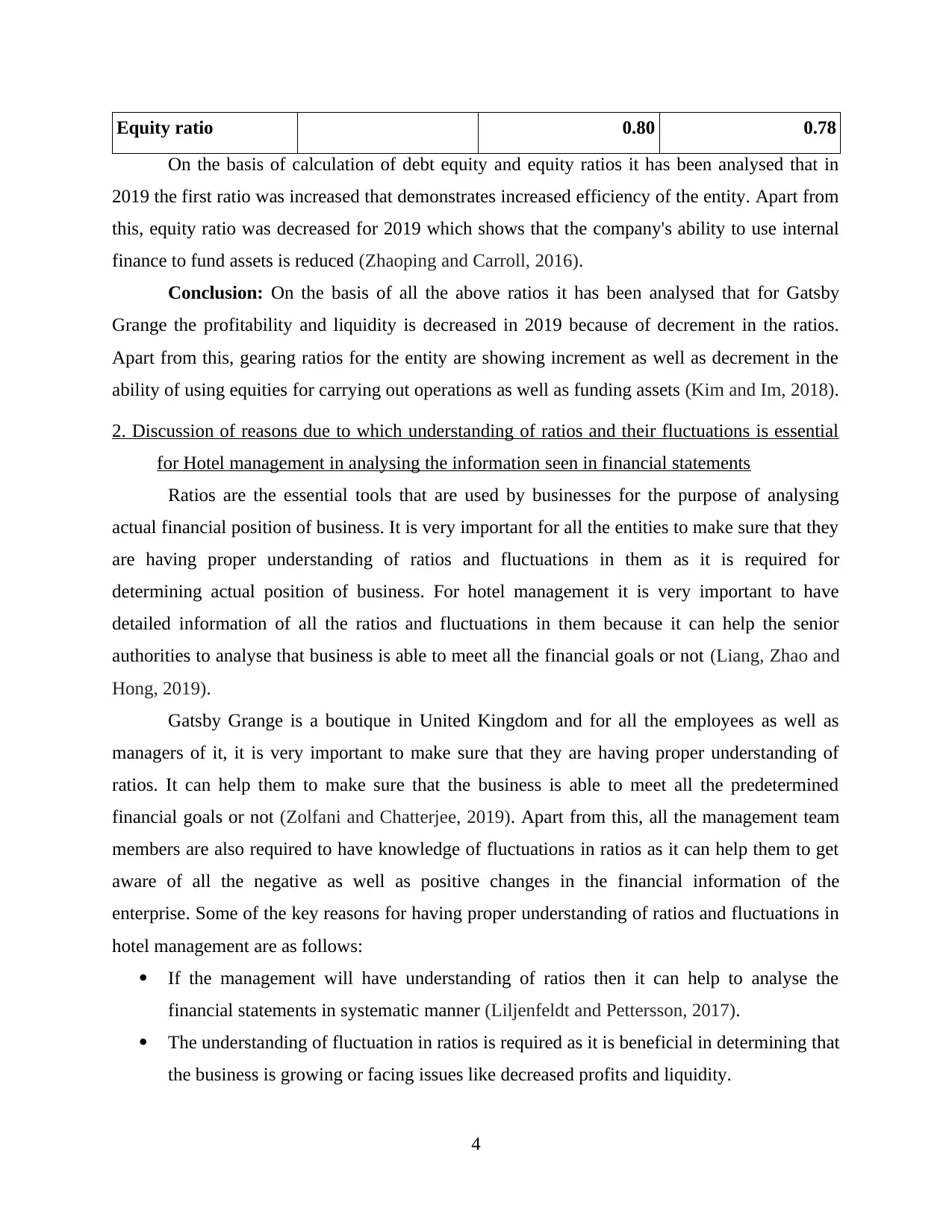
Equity ratio 0.80 0.78
On the basis of calculation of debt equity and equity ratios it has been analysed that in
2019 the first ratio was increased that demonstrates increased efficiency of the entity. Apart from
this, equity ratio was decreased for 2019 which shows that the company's ability to use internal
finance to fund assets is reduced (Zhaoping and Carroll, 2016).
Conclusion: On the basis of all the above ratios it has been analysed that for Gatsby
Grange the profitability and liquidity is decreased in 2019 because of decrement in the ratios.
Apart from this, gearing ratios for the entity are showing increment as well as decrement in the
ability of using equities for carrying out operations as well as funding assets (Kim and Im, 2018).
2. Discussion of reasons due to which understanding of ratios and their fluctuations is essential
for Hotel management in analysing the information seen in financial statements
Ratios are the essential tools that are used by businesses for the purpose of analysing
actual financial position of business. It is very important for all the entities to make sure that they
are having proper understanding of ratios and fluctuations in them as it is required for
determining actual position of business. For hotel management it is very important to have
detailed information of all the ratios and fluctuations in them because it can help the senior
authorities to analyse that business is able to meet all the financial goals or not (Liang, Zhao and
Hong, 2019).
Gatsby Grange is a boutique in United Kingdom and for all the employees as well as
managers of it, it is very important to make sure that they are having proper understanding of
ratios. It can help them to make sure that the business is able to meet all the predetermined
financial goals or not (Zolfani and Chatterjee, 2019). Apart from this, all the management team
members are also required to have knowledge of fluctuations in ratios as it can help them to get
aware of all the negative as well as positive changes in the financial information of the
enterprise. Some of the key reasons for having proper understanding of ratios and fluctuations in
hotel management are as follows:
If the management will have understanding of ratios then it can help to analyse the
financial statements in systematic manner (Liljenfeldt and Pettersson, 2017).
The understanding of fluctuation in ratios is required as it is beneficial in determining that
the business is growing or facing issues like decreased profits and liquidity.
4
On the basis of calculation of debt equity and equity ratios it has been analysed that in
2019 the first ratio was increased that demonstrates increased efficiency of the entity. Apart from
this, equity ratio was decreased for 2019 which shows that the company's ability to use internal
finance to fund assets is reduced (Zhaoping and Carroll, 2016).
Conclusion: On the basis of all the above ratios it has been analysed that for Gatsby
Grange the profitability and liquidity is decreased in 2019 because of decrement in the ratios.
Apart from this, gearing ratios for the entity are showing increment as well as decrement in the
ability of using equities for carrying out operations as well as funding assets (Kim and Im, 2018).
2. Discussion of reasons due to which understanding of ratios and their fluctuations is essential
for Hotel management in analysing the information seen in financial statements
Ratios are the essential tools that are used by businesses for the purpose of analysing
actual financial position of business. It is very important for all the entities to make sure that they
are having proper understanding of ratios and fluctuations in them as it is required for
determining actual position of business. For hotel management it is very important to have
detailed information of all the ratios and fluctuations in them because it can help the senior
authorities to analyse that business is able to meet all the financial goals or not (Liang, Zhao and
Hong, 2019).
Gatsby Grange is a boutique in United Kingdom and for all the employees as well as
managers of it, it is very important to make sure that they are having proper understanding of
ratios. It can help them to make sure that the business is able to meet all the predetermined
financial goals or not (Zolfani and Chatterjee, 2019). Apart from this, all the management team
members are also required to have knowledge of fluctuations in ratios as it can help them to get
aware of all the negative as well as positive changes in the financial information of the
enterprise. Some of the key reasons for having proper understanding of ratios and fluctuations in
hotel management are as follows:
If the management will have understanding of ratios then it can help to analyse the
financial statements in systematic manner (Liljenfeldt and Pettersson, 2017).
The understanding of fluctuation in ratios is required as it is beneficial in determining that
the business is growing or facing issues like decreased profits and liquidity.
4
⊘ This is a preview!⊘
Do you want full access?
Subscribe today to unlock all pages.

Trusted by 1+ million students worldwide
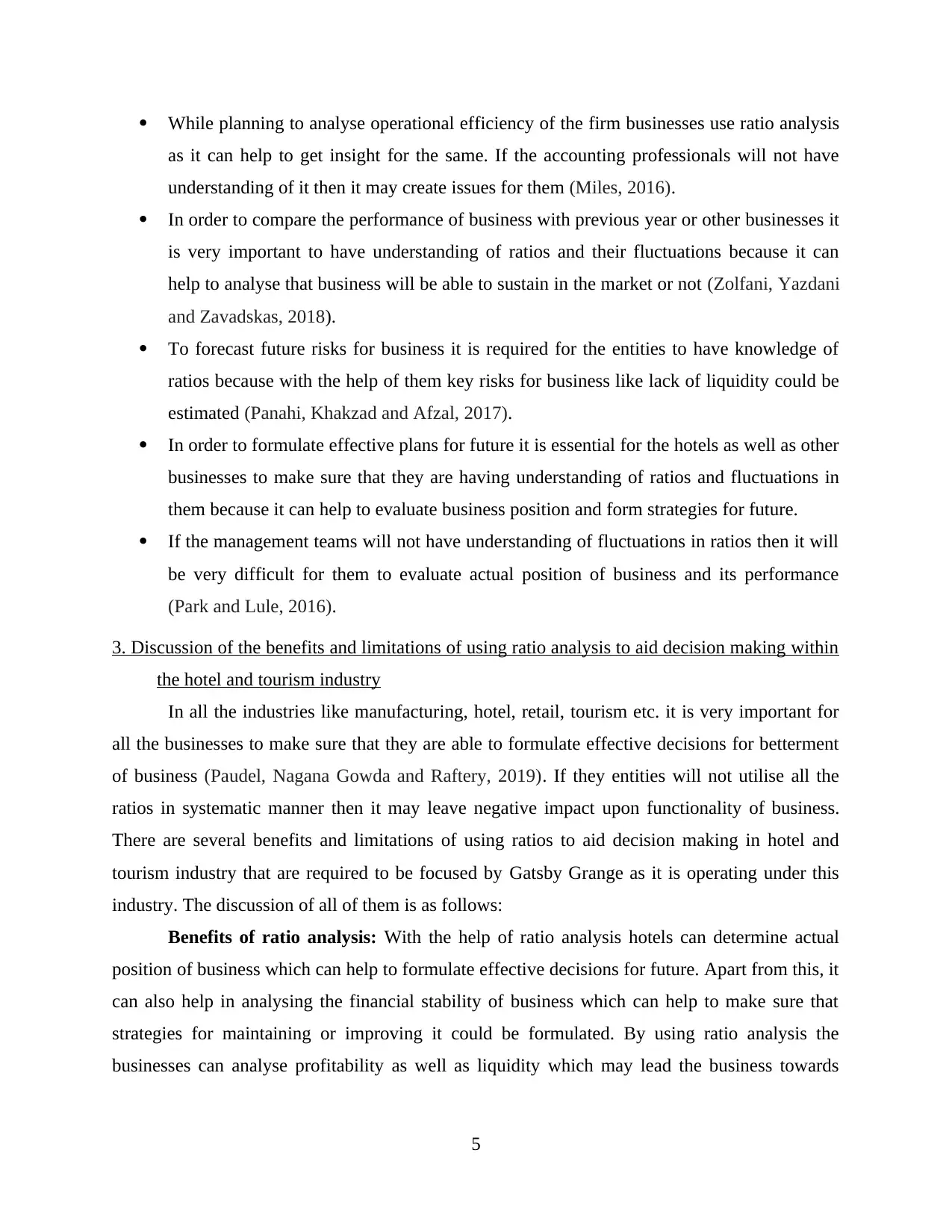
While planning to analyse operational efficiency of the firm businesses use ratio analysis
as it can help to get insight for the same. If the accounting professionals will not have
understanding of it then it may create issues for them (Miles, 2016).
In order to compare the performance of business with previous year or other businesses it
is very important to have understanding of ratios and their fluctuations because it can
help to analyse that business will be able to sustain in the market or not (Zolfani, Yazdani
and Zavadskas, 2018).
To forecast future risks for business it is required for the entities to have knowledge of
ratios because with the help of them key risks for business like lack of liquidity could be
estimated (Panahi, Khakzad and Afzal, 2017).
In order to formulate effective plans for future it is essential for the hotels as well as other
businesses to make sure that they are having understanding of ratios and fluctuations in
them because it can help to evaluate business position and form strategies for future.
If the management teams will not have understanding of fluctuations in ratios then it will
be very difficult for them to evaluate actual position of business and its performance
(Park and Lule, 2016).
3. Discussion of the benefits and limitations of using ratio analysis to aid decision making within
the hotel and tourism industry
In all the industries like manufacturing, hotel, retail, tourism etc. it is very important for
all the businesses to make sure that they are able to formulate effective decisions for betterment
of business (Paudel, Nagana Gowda and Raftery, 2019). If they entities will not utilise all the
ratios in systematic manner then it may leave negative impact upon functionality of business.
There are several benefits and limitations of using ratios to aid decision making in hotel and
tourism industry that are required to be focused by Gatsby Grange as it is operating under this
industry. The discussion of all of them is as follows:
Benefits of ratio analysis: With the help of ratio analysis hotels can determine actual
position of business which can help to formulate effective decisions for future. Apart from this, it
can also help in analysing the financial stability of business which can help to make sure that
strategies for maintaining or improving it could be formulated. By using ratio analysis the
businesses can analyse profitability as well as liquidity which may lead the business towards
5
as it can help to get insight for the same. If the accounting professionals will not have
understanding of it then it may create issues for them (Miles, 2016).
In order to compare the performance of business with previous year or other businesses it
is very important to have understanding of ratios and their fluctuations because it can
help to analyse that business will be able to sustain in the market or not (Zolfani, Yazdani
and Zavadskas, 2018).
To forecast future risks for business it is required for the entities to have knowledge of
ratios because with the help of them key risks for business like lack of liquidity could be
estimated (Panahi, Khakzad and Afzal, 2017).
In order to formulate effective plans for future it is essential for the hotels as well as other
businesses to make sure that they are having understanding of ratios and fluctuations in
them because it can help to evaluate business position and form strategies for future.
If the management teams will not have understanding of fluctuations in ratios then it will
be very difficult for them to evaluate actual position of business and its performance
(Park and Lule, 2016).
3. Discussion of the benefits and limitations of using ratio analysis to aid decision making within
the hotel and tourism industry
In all the industries like manufacturing, hotel, retail, tourism etc. it is very important for
all the businesses to make sure that they are able to formulate effective decisions for betterment
of business (Paudel, Nagana Gowda and Raftery, 2019). If they entities will not utilise all the
ratios in systematic manner then it may leave negative impact upon functionality of business.
There are several benefits and limitations of using ratios to aid decision making in hotel and
tourism industry that are required to be focused by Gatsby Grange as it is operating under this
industry. The discussion of all of them is as follows:
Benefits of ratio analysis: With the help of ratio analysis hotels can determine actual
position of business which can help to formulate effective decisions for future. Apart from this, it
can also help in analysing the financial stability of business which can help to make sure that
strategies for maintaining or improving it could be formulated. By using ratio analysis the
businesses can analyse profitability as well as liquidity which may lead the business towards
5
Paraphrase This Document
Need a fresh take? Get an instant paraphrase of this document with our AI Paraphraser
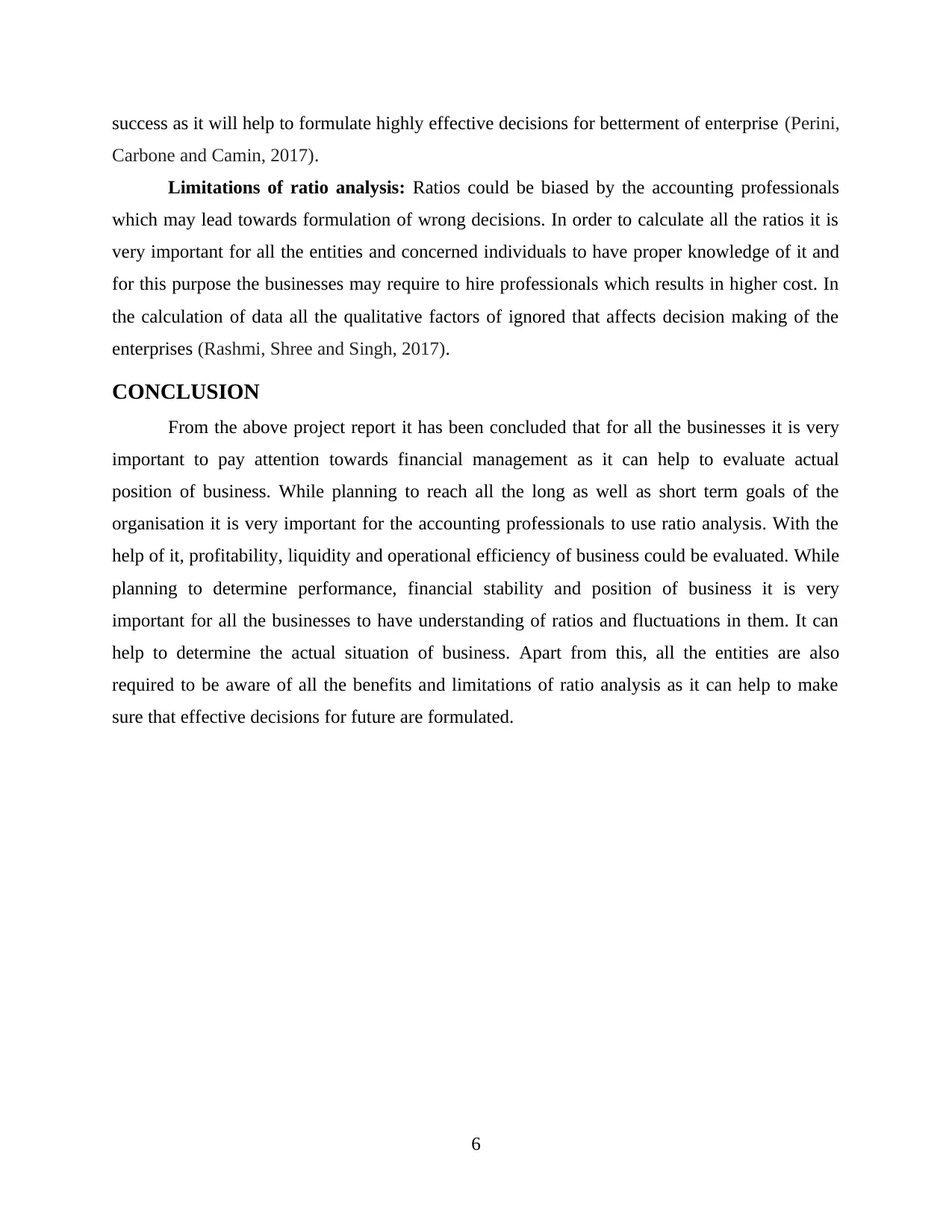
success as it will help to formulate highly effective decisions for betterment of enterprise (Perini,
Carbone and Camin, 2017).
Limitations of ratio analysis: Ratios could be biased by the accounting professionals
which may lead towards formulation of wrong decisions. In order to calculate all the ratios it is
very important for all the entities and concerned individuals to have proper knowledge of it and
for this purpose the businesses may require to hire professionals which results in higher cost. In
the calculation of data all the qualitative factors of ignored that affects decision making of the
enterprises (Rashmi, Shree and Singh, 2017).
CONCLUSION
From the above project report it has been concluded that for all the businesses it is very
important to pay attention towards financial management as it can help to evaluate actual
position of business. While planning to reach all the long as well as short term goals of the
organisation it is very important for the accounting professionals to use ratio analysis. With the
help of it, profitability, liquidity and operational efficiency of business could be evaluated. While
planning to determine performance, financial stability and position of business it is very
important for all the businesses to have understanding of ratios and fluctuations in them. It can
help to determine the actual situation of business. Apart from this, all the entities are also
required to be aware of all the benefits and limitations of ratio analysis as it can help to make
sure that effective decisions for future are formulated.
6
Carbone and Camin, 2017).
Limitations of ratio analysis: Ratios could be biased by the accounting professionals
which may lead towards formulation of wrong decisions. In order to calculate all the ratios it is
very important for all the entities and concerned individuals to have proper knowledge of it and
for this purpose the businesses may require to hire professionals which results in higher cost. In
the calculation of data all the qualitative factors of ignored that affects decision making of the
enterprises (Rashmi, Shree and Singh, 2017).
CONCLUSION
From the above project report it has been concluded that for all the businesses it is very
important to pay attention towards financial management as it can help to evaluate actual
position of business. While planning to reach all the long as well as short term goals of the
organisation it is very important for the accounting professionals to use ratio analysis. With the
help of it, profitability, liquidity and operational efficiency of business could be evaluated. While
planning to determine performance, financial stability and position of business it is very
important for all the businesses to have understanding of ratios and fluctuations in them. It can
help to determine the actual situation of business. Apart from this, all the entities are also
required to be aware of all the benefits and limitations of ratio analysis as it can help to make
sure that effective decisions for future are formulated.
6
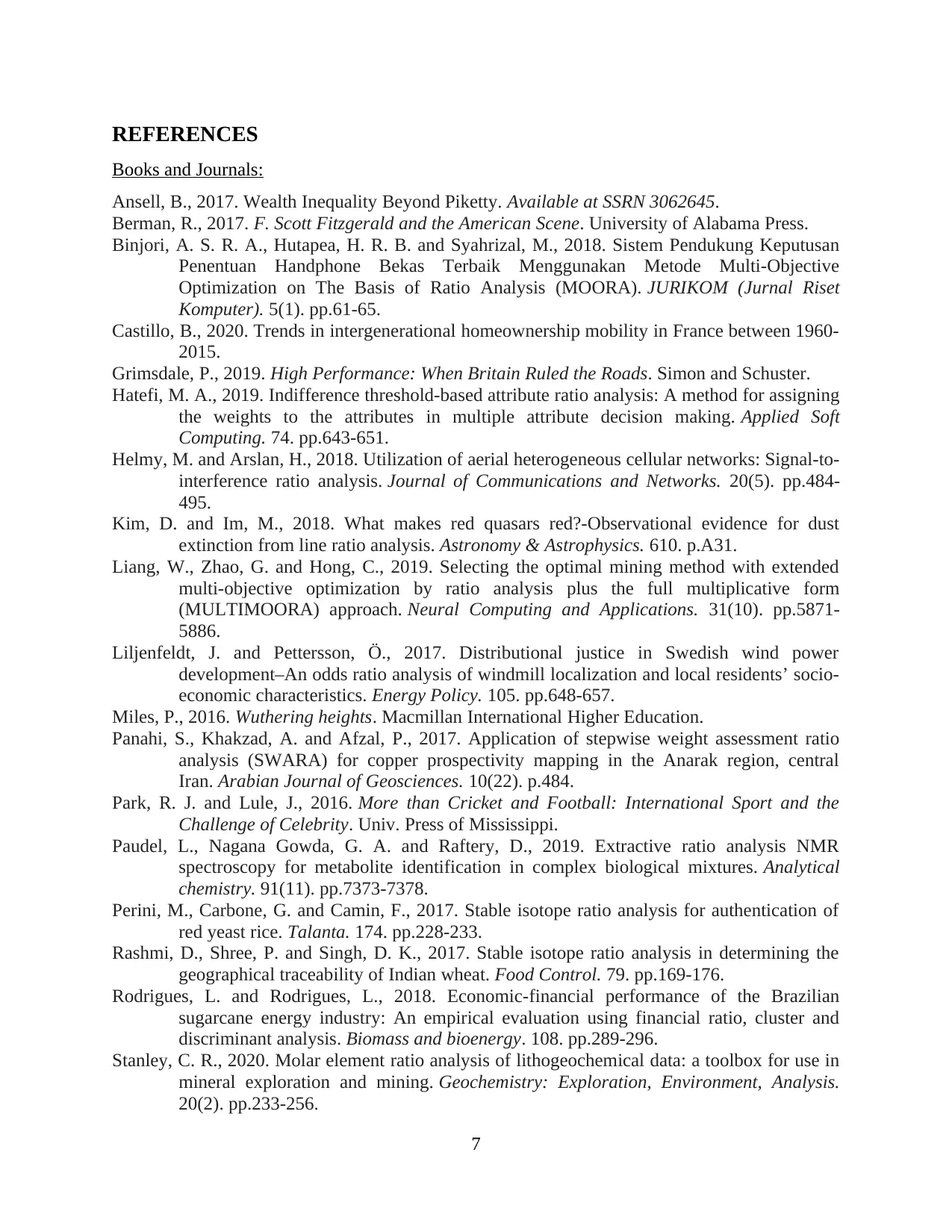
REFERENCES
Books and Journals:
Ansell, B., 2017. Wealth Inequality Beyond Piketty. Available at SSRN 3062645.
Berman, R., 2017. F. Scott Fitzgerald and the American Scene. University of Alabama Press.
Binjori, A. S. R. A., Hutapea, H. R. B. and Syahrizal, M., 2018. Sistem Pendukung Keputusan
Penentuan Handphone Bekas Terbaik Menggunakan Metode Multi-Objective
Optimization on The Basis of Ratio Analysis (MOORA). JURIKOM (Jurnal Riset
Komputer). 5(1). pp.61-65.
Castillo, B., 2020. Trends in intergenerational homeownership mobility in France between 1960-
2015.
Grimsdale, P., 2019. High Performance: When Britain Ruled the Roads. Simon and Schuster.
Hatefi, M. A., 2019. Indifference threshold-based attribute ratio analysis: A method for assigning
the weights to the attributes in multiple attribute decision making. Applied Soft
Computing. 74. pp.643-651.
Helmy, M. and Arslan, H., 2018. Utilization of aerial heterogeneous cellular networks: Signal-to-
interference ratio analysis. Journal of Communications and Networks. 20(5). pp.484-
495.
Kim, D. and Im, M., 2018. What makes red quasars red?-Observational evidence for dust
extinction from line ratio analysis. Astronomy & Astrophysics. 610. p.A31.
Liang, W., Zhao, G. and Hong, C., 2019. Selecting the optimal mining method with extended
multi-objective optimization by ratio analysis plus the full multiplicative form
(MULTIMOORA) approach. Neural Computing and Applications. 31(10). pp.5871-
5886.
Liljenfeldt, J. and Pettersson, Ö., 2017. Distributional justice in Swedish wind power
development–An odds ratio analysis of windmill localization and local residents’ socio-
economic characteristics. Energy Policy. 105. pp.648-657.
Miles, P., 2016. Wuthering heights. Macmillan International Higher Education.
Panahi, S., Khakzad, A. and Afzal, P., 2017. Application of stepwise weight assessment ratio
analysis (SWARA) for copper prospectivity mapping in the Anarak region, central
Iran. Arabian Journal of Geosciences. 10(22). p.484.
Park, R. J. and Lule, J., 2016. More than Cricket and Football: International Sport and the
Challenge of Celebrity. Univ. Press of Mississippi.
Paudel, L., Nagana Gowda, G. A. and Raftery, D., 2019. Extractive ratio analysis NMR
spectroscopy for metabolite identification in complex biological mixtures. Analytical
chemistry. 91(11). pp.7373-7378.
Perini, M., Carbone, G. and Camin, F., 2017. Stable isotope ratio analysis for authentication of
red yeast rice. Talanta. 174. pp.228-233.
Rashmi, D., Shree, P. and Singh, D. K., 2017. Stable isotope ratio analysis in determining the
geographical traceability of Indian wheat. Food Control. 79. pp.169-176.
Rodrigues, L. and Rodrigues, L., 2018. Economic-financial performance of the Brazilian
sugarcane energy industry: An empirical evaluation using financial ratio, cluster and
discriminant analysis. Biomass and bioenergy. 108. pp.289-296.
Stanley, C. R., 2020. Molar element ratio analysis of lithogeochemical data: a toolbox for use in
mineral exploration and mining. Geochemistry: Exploration, Environment, Analysis.
20(2). pp.233-256.
7
Books and Journals:
Ansell, B., 2017. Wealth Inequality Beyond Piketty. Available at SSRN 3062645.
Berman, R., 2017. F. Scott Fitzgerald and the American Scene. University of Alabama Press.
Binjori, A. S. R. A., Hutapea, H. R. B. and Syahrizal, M., 2018. Sistem Pendukung Keputusan
Penentuan Handphone Bekas Terbaik Menggunakan Metode Multi-Objective
Optimization on The Basis of Ratio Analysis (MOORA). JURIKOM (Jurnal Riset
Komputer). 5(1). pp.61-65.
Castillo, B., 2020. Trends in intergenerational homeownership mobility in France between 1960-
2015.
Grimsdale, P., 2019. High Performance: When Britain Ruled the Roads. Simon and Schuster.
Hatefi, M. A., 2019. Indifference threshold-based attribute ratio analysis: A method for assigning
the weights to the attributes in multiple attribute decision making. Applied Soft
Computing. 74. pp.643-651.
Helmy, M. and Arslan, H., 2018. Utilization of aerial heterogeneous cellular networks: Signal-to-
interference ratio analysis. Journal of Communications and Networks. 20(5). pp.484-
495.
Kim, D. and Im, M., 2018. What makes red quasars red?-Observational evidence for dust
extinction from line ratio analysis. Astronomy & Astrophysics. 610. p.A31.
Liang, W., Zhao, G. and Hong, C., 2019. Selecting the optimal mining method with extended
multi-objective optimization by ratio analysis plus the full multiplicative form
(MULTIMOORA) approach. Neural Computing and Applications. 31(10). pp.5871-
5886.
Liljenfeldt, J. and Pettersson, Ö., 2017. Distributional justice in Swedish wind power
development–An odds ratio analysis of windmill localization and local residents’ socio-
economic characteristics. Energy Policy. 105. pp.648-657.
Miles, P., 2016. Wuthering heights. Macmillan International Higher Education.
Panahi, S., Khakzad, A. and Afzal, P., 2017. Application of stepwise weight assessment ratio
analysis (SWARA) for copper prospectivity mapping in the Anarak region, central
Iran. Arabian Journal of Geosciences. 10(22). p.484.
Park, R. J. and Lule, J., 2016. More than Cricket and Football: International Sport and the
Challenge of Celebrity. Univ. Press of Mississippi.
Paudel, L., Nagana Gowda, G. A. and Raftery, D., 2019. Extractive ratio analysis NMR
spectroscopy for metabolite identification in complex biological mixtures. Analytical
chemistry. 91(11). pp.7373-7378.
Perini, M., Carbone, G. and Camin, F., 2017. Stable isotope ratio analysis for authentication of
red yeast rice. Talanta. 174. pp.228-233.
Rashmi, D., Shree, P. and Singh, D. K., 2017. Stable isotope ratio analysis in determining the
geographical traceability of Indian wheat. Food Control. 79. pp.169-176.
Rodrigues, L. and Rodrigues, L., 2018. Economic-financial performance of the Brazilian
sugarcane energy industry: An empirical evaluation using financial ratio, cluster and
discriminant analysis. Biomass and bioenergy. 108. pp.289-296.
Stanley, C. R., 2020. Molar element ratio analysis of lithogeochemical data: a toolbox for use in
mineral exploration and mining. Geochemistry: Exploration, Environment, Analysis.
20(2). pp.233-256.
7
⊘ This is a preview!⊘
Do you want full access?
Subscribe today to unlock all pages.

Trusted by 1+ million students worldwide
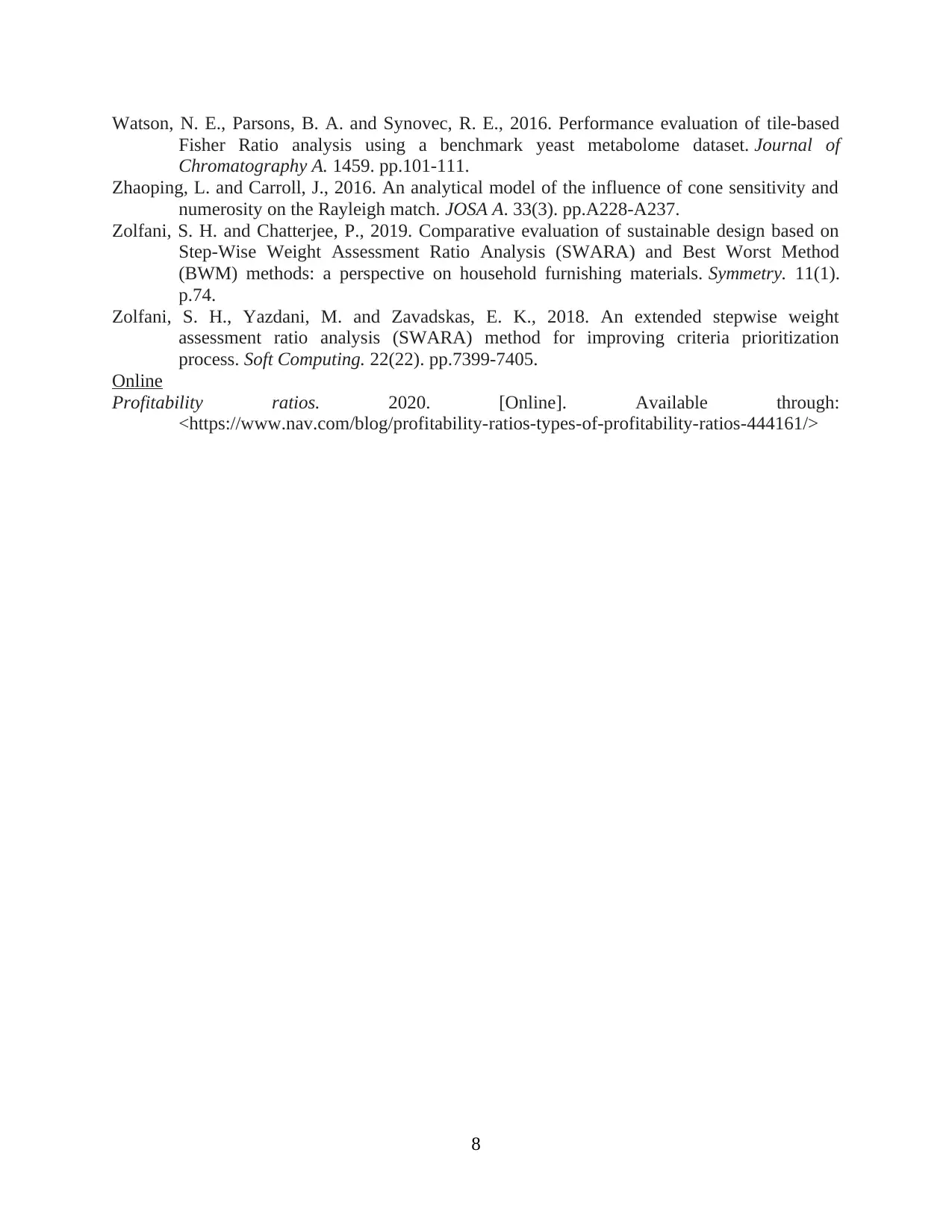
Watson, N. E., Parsons, B. A. and Synovec, R. E., 2016. Performance evaluation of tile-based
Fisher Ratio analysis using a benchmark yeast metabolome dataset. Journal of
Chromatography A. 1459. pp.101-111.
Zhaoping, L. and Carroll, J., 2016. An analytical model of the influence of cone sensitivity and
numerosity on the Rayleigh match. JOSA A. 33(3). pp.A228-A237.
Zolfani, S. H. and Chatterjee, P., 2019. Comparative evaluation of sustainable design based on
Step-Wise Weight Assessment Ratio Analysis (SWARA) and Best Worst Method
(BWM) methods: a perspective on household furnishing materials. Symmetry. 11(1).
p.74.
Zolfani, S. H., Yazdani, M. and Zavadskas, E. K., 2018. An extended stepwise weight
assessment ratio analysis (SWARA) method for improving criteria prioritization
process. Soft Computing. 22(22). pp.7399-7405.
Online
Profitability ratios. 2020. [Online]. Available through:
<https://www.nav.com/blog/profitability-ratios-types-of-profitability-ratios-444161/>
8
Fisher Ratio analysis using a benchmark yeast metabolome dataset. Journal of
Chromatography A. 1459. pp.101-111.
Zhaoping, L. and Carroll, J., 2016. An analytical model of the influence of cone sensitivity and
numerosity on the Rayleigh match. JOSA A. 33(3). pp.A228-A237.
Zolfani, S. H. and Chatterjee, P., 2019. Comparative evaluation of sustainable design based on
Step-Wise Weight Assessment Ratio Analysis (SWARA) and Best Worst Method
(BWM) methods: a perspective on household furnishing materials. Symmetry. 11(1).
p.74.
Zolfani, S. H., Yazdani, M. and Zavadskas, E. K., 2018. An extended stepwise weight
assessment ratio analysis (SWARA) method for improving criteria prioritization
process. Soft Computing. 22(22). pp.7399-7405.
Online
Profitability ratios. 2020. [Online]. Available through:
<https://www.nav.com/blog/profitability-ratios-types-of-profitability-ratios-444161/>
8
1 out of 10
Related Documents
Your All-in-One AI-Powered Toolkit for Academic Success.
+13062052269
info@desklib.com
Available 24*7 on WhatsApp / Email
![[object Object]](/_next/static/media/star-bottom.7253800d.svg)
Unlock your academic potential
Copyright © 2020–2025 A2Z Services. All Rights Reserved. Developed and managed by ZUCOL.





